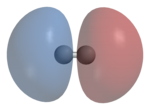
Back مدار جزيئي مضاد للترابط Arabic Antivezanje BS Orbital d'antienllaç Catalan Antivazebné molekulové orbitaly Czech Antiliga molekula orbitalo Esperanto Orbital de antienlace Spanish Orbital antilotzaile Basque پادپیوند Persian Orbitale antiliante French Lazítópálya Hungarian
This article needs additional citations for verification. (August 2012) |
This article includes a list of general references, but it lacks sufficient corresponding inline citations. (August 2012) |

In theoretical chemistry, an antibonding orbital is a type of molecular orbital that weakens the chemical bond between two atoms and helps to raise the energy of the molecule relative to the separated atoms. Such an orbital has one or more nodes in the bonding region between the nuclei. The density of the electrons in the orbital is concentrated outside the bonding region and acts to pull one nucleus away from the other and tends to cause mutual repulsion between the two atoms.[1][2] This is in contrast to a bonding molecular orbital, which has a lower energy than that of the separate atoms, and is responsible for chemical bonds.
- ^ Atkins P. and de Paula J. Atkins Physical Chemistry. 8th ed. (W.H. Freeman 2006), p.371 ISBN 0-7167-8759-8
- ^ Miessler G.L. and Tarr D.A., Inorganic Chemistry 2nd ed. (Prentice-Hall 1999), p.111 ISBN 0-13-841891-8